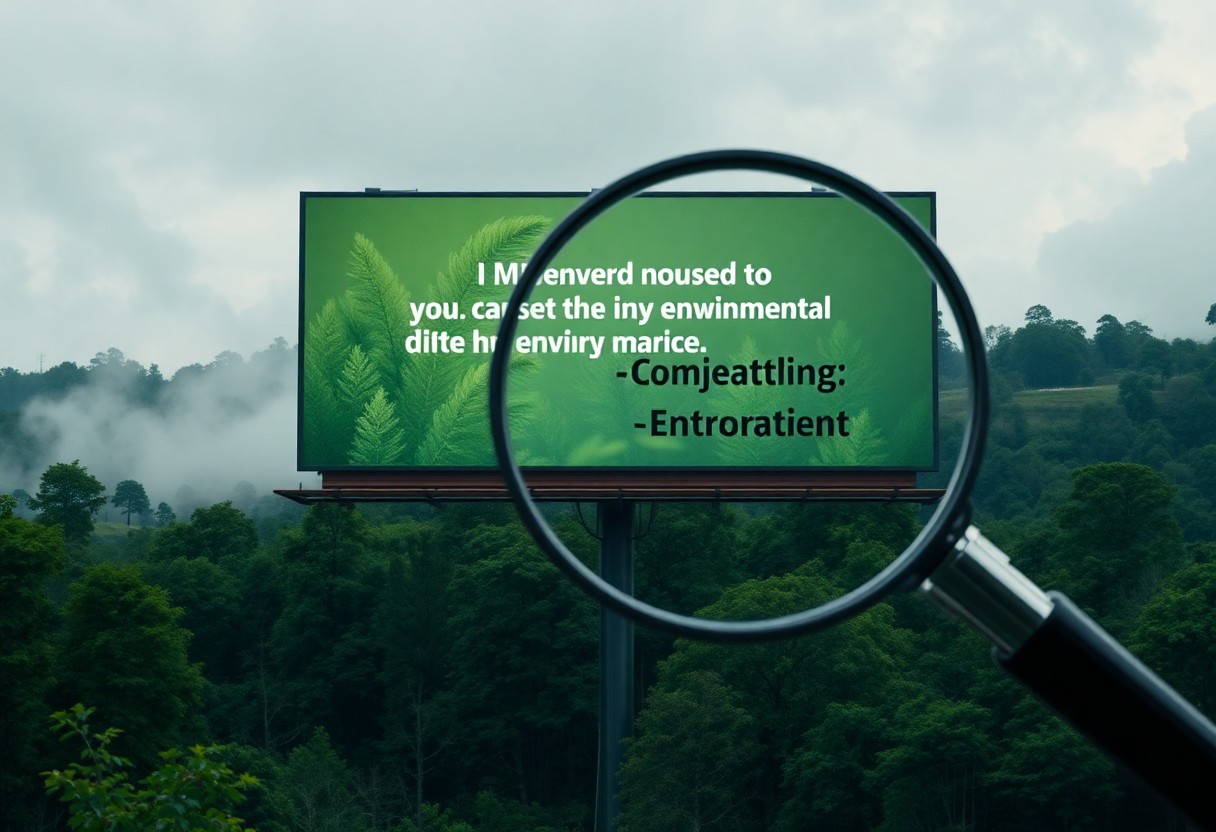This guide aims to empower you with the knowledge to spot greenwashing in marketing and product claims. Companies often exploit your desire to make eco-friendly choices by promoting misleading environmental benefits. By developing a keen eye for red flags and understanding the language used in advertising, you can ensure your purchases truly align with your values. In the following sections, you’ll learn effective strategies to distinguish genuine sustainability efforts from empty promises, helping you make informed decisions that positively impact the environment.
Table of Contents
Key Takeaways:
- Beware of vague language: Terms like “eco-friendly” and “green” can be subjective and lacking in specific criteria.
- Look for certifications: Trustworthy environmental claims are often backed by recognized certifications from credible organizations.
- Investigate the company: Research the brand’s overall environmental practices to see if their claims align with their actions.
- Check for transparency: Genuine companies will provide detailed information about their environmental impact and sustainability practices.
- Compare products: Evaluate multiple options to see if the claims stand up in comparison to similar products or competitors.

Understanding Greenwashing
To effectively combat greenwashing, it’s vital to understand what it entails. This misleading practice often leads consumers to believe that a company’s products or practices are more environmentally friendly than they actually are. By presenting an image of sustainability without any true commitment to environmentally sound practices, businesses exploit your trust. This act not only misguides consumers but can also harm genuinely eco-friendly companies striving for authenticity.
Definition of Greenwashing
Clearly, greenwashing occurs when organizations emphasize their environmental initiatives while downplaying or omitting negative environmental impacts. This deceptive practice can manifest in various forms, from misleading advertising to vague language that doesn’t hold up under scrutiny. Understanding the definition of greenwashing is the first step in protecting yourself and making informed choices, as both consumers and advocates for sustainable practices.
Common Types of Greenwashing
Clearly, there are several prevalent forms of greenwashing that you should be aware of. These include false or misleading environmental claims, vague terms that lack clear definitions, and optimistic statements about sustainability that are not backed by credible evidence. Each type can create an illusion of environmental responsibility while merely masking underlying issues. Here are some examples of common greenwashing techniques:
| Type of Greenwashing | Description |
| Vague Claims | Using ambiguous terms, like “eco-friendly” or “natural,” without proper definitions. |
| Irrelevant Claims | Mentioning an environmentally friendly aspect that is irrelevant to the product’s overall impact. |
| Lesser of Two Evils | Marketing a more sustainable version of a harmful product as a major environmental achievement. |
| Hidden Trade-offs | Focusing on one environmentally friendly feature while ignoring ecological harm in other areas. |
| False Labels | Creating fake certifications or logos suggesting external validation of environmental friendliness. |
Even the most well-intentioned companies can accidentally engage in greenwashing due to competition and market demands. It’s vital for you to critically evaluate the claims made by brands before making purchasing decisions. Companies often prioritize marketing sustainability over implementing genuine eco-friendly practices, which can lead to confusion and misinformation. Here are other common types of greenwashing to consider:
- Distracting Claims
- Imagery
- Countless certifications
- Exaggeration
Knowing the different forms of greenwashing will empower you to make more informed choices regarding the products you purchase and the companies you support.
Key Factors Behind Greenwashing
Clearly, multiple factors contribute to the prevalence of greenwashing in today’s market. The increasing consumer demand for sustainable products creates a pressure on businesses to present themselves as environmentally conscious, regardless of their actual practices. Additionally, the lack of stringent regulations surrounding environmental claims leads many companies to take advantage of this loophole, resulting in misleading advertising and corporate practices.
- Consumer Demand
- Protection Loopholes
- Costly Changes
- Marketing Strategies
The widespread lack of awareness about the seriousness and implications of greenwashing means even responsible consumers can fall victim to these misleading practices. The business environment you engage with often values profit over genuine sustainability.
The rise of social media and digital marketing has further enabled the spread of misleading claims. Companies can easily fabricate narratives about their commitment to sustainability without ample verification from peer review or third-party organizations. You should look for transparency and confirmation through reputable sources to ensure you are supporting responsible companies.
- Digital Marketing
- Social Media Influence
- Consumer Misinformation
- Peer Pressure
Thou must always remain vigilant and question sustainability narratives in marketing to cultivate sustainable purchasing habits. Your choices can drive demand for authentic eco-friendly practices while discouraging deceptive tactics.
How to Identify Greenwashing
Now that you are aware of the potential for greenwashing, it is imperative to know how to identify misleading environmental claims. Understanding the tactics companies use to frame their sustainability initiatives can empower you to make informed choices and support genuinely eco-friendly products and practices.
Recognizing Vague Claims
For a claim to be credible, it should be specific and verifiable. If you come across terms like “eco-friendly,” “green,” or “natural” without a clear explanation, it may be a sign of vagueness that could lead to greenwashing. When companies use ambiguous language, they often attempt to divert your attention from their less sustainable practices. Take the time to dig deeper and question what these terms really mean.
Additionally, look for a lack of evidence or supporting details around the claimed benefits. When a product or company promotes an environmental initiative without offering any concrete figures, independent assessments, or evidence of its positive impact, it raises a red flag. Companies that genuinely prioritize sustainability should be willing to share specific, quantifiable information about their efforts.
Scrutinizing Certifications and Labels
Identify the certifications and labels associated with the products you are considering. While some certifications are legitimate and thoroughly vetted, others may be self-proclaimed or lack rigorous standards. Check if the labels are backed by credible organizations and have undergone stringent evaluation processes to ensure authenticity.
It’s also important to be wary of certifications that sound similar to reputable ones but may not have the same level of recognition. Scammers often create their labels or use similar logos to provide a false sense of credibility. Be sure to research the organization behind the certification and verify its integrity to avoid being misled.
Evaluating Company Commitments
To better understand a company’s environmental stance, evaluate their commitments and actions over time. A company that regularly updates its sustainability goals and provides transparent reports on progress is likely to take its environmental responsibilities seriously. On the other hand, if you find a lack of consistency in a company’s sustainability messaging or if their initiatives are in response to public pressure rather than genuine concern, it can signify an inclination towards greenwashing.
The more transparent a company is about its supply chain, practices, and environmental impacts, the more trust you can place in their claims. Engaging with a company’s policies and checking for third-party audits can further help you assess the authenticity of their promises.
Importance of Transparency
Assuming that all companies embrace transparency puts you at risk of falling for greenwashing tactics. Genuine organizations actively communicate their sustainability strategies and provide clear, accessible information about their practices. When a company is open about its environmental impacts and embraces accountability, it helps you make informed purchasing decisions and supports your commitment to sustainable consumption.
Furthermore, transparent companies often allow for dialogue and feedback from consumers about their practices, fostering an environment of sustainability as a shared value. This openness ultimately encourages ethical business practices and helps you contribute positively to environmental efforts through informed choices.
Greenwashing often relies on manipulation and obscured truths to mislead consumers. By prioritizing transparency and demanding clarity in environmental claims, you contribute to a marketplace that values true sustainability. Taking the time to critically assess the information available will enhance your ability to discern between genuine eco-friendly options and deceptive marketing strategies.

Tips for Consumers
Once again, it’s important to stay vigilant when shopping for products that boast environmental credentials. Greenwashing can be misleading, but with a few strategies, you can make informed choices that truly align with your values. Here are some tips to help you identify and avoid misleading environmental claims:
- Research brands and products thoroughly.
- Look for third-party reviews and certifications.
- Understand environmental impact metrics.
- Engage with brands on sustainability initiatives.
Researching Brands and Products
Researching brands before making a purchase is a fundamental step towards avoiding greenwashing. Dive deep into the company’s history, values, and manufacturing processes. This involves exploring their official websites, reading about their sustainability initiatives, and checking for transparency regarding their environmental practices. Look out for any partnerships they have with recognized environmental organizations, as this can be a solid indicator of their commitment to genuine sustainability.
Additionally, it’s beneficial to investigate the sourcing and ingredient lists of the products you are considering. Companies that are committed to sustainability often provide detailed information about where their materials come from and how they impact the environment. Assessing these claims critically can help you determine the authenticity of their environmental commitments.
Looking for Third-Party Reviews
If you’re uncertain about a brand’s sustainability claims, looking for third-party reviews can provide clarity. Sources such as independent product review sites and sustainability-focused organizations can shed light on whether a brand’s practices align with their claims. These platforms often analyze products based on rigorous criteria, assessing their environmental impact and ethical practices.
Reviews from consumers can also be quite telling. Genuinely satisfied customers—especially those passionate about sustainability—often share their experiences and thoughts on whether a product lives up to its eco-friendly promises. This crowd-sourced information can serve as an additional layer of assurance as you navigate through potential greenwashing tactics.
Understanding Environmental Impact Metrics
Assuming that a product is sustainable just because it is marketed as such can lead to misinformed purchasing decisions. Understanding environmental impact metrics means deciphering how different products are assessed against sustainability criteria. Look for metrics related to carbon footprint, recycling rates, and water usage. Be cautious, as some companies might present misleading statistics that sound promising but lack context.
This knowledge allows you to critically evaluate the claims that brands make about their products. For instance, if a product boasts of “eco-friendly” materials but lacks details on how it measures up in terms of its carbon impact, you may want to dig deeper before making a purchase.
Engaging with Brands on Sustainability
ThirdParty engagement with brands regarding their sustainability efforts can be proactive. Don’t hesitate to ask questions about their practices, sourcing, and how they are addressing their environmental impact. A reputable company will value consumer inquiries and provide transparent answers. By doing this, you not only arm yourself with information but can hold the companies accountable for their environmental promises.
Environmental engagement can also extend to social media. Many brands monitor platforms for customer feedback and inquiries. By publicly engaging with them, you not only gather insights but might also encourage other consumers to do the same, creating a community committed to understanding and promoting genuine sustainability.
After you implement these strategies, you’ll be better equipped to make choices that align not just with your values but also with true environmental sustainability.

Recognizing Red Flags
Your ability to identify misleading environmental claims is important in navigating the often murky waters of green marketing. One of the first places to look for red flags is in the company’s overall practices and values. By examining their actions and overall environmental impact, you can discern whether their claims hold any weight.
Contradictory Practices
On one hand, a company may boldly advertise its eco-conscious initiatives, yet on the other hand, its operations tell a different story. If a brand promotes its commitment to sustainability while frequently engaging in environmentally damaging practices, this is a clear red flag. For instance, a company might boast about its recyclable packaging while neglecting to address excessive carbon emissions from its production processes.
Overemphasis on Eco-Friendly Packaging
For many companies, it’s tempting to focus on selling their eco-friendly packaging as a primary selling point. While using sustainable materials for packaging is important, it’s important to look beyond just this aspect. A business that places excessive emphasis on eco-friendly packaging might be diverting your attention from less sustainable practices elsewhere in its operations, suggesting a larger issue of greenwashing. They may be using this tactic to present a more virtuous image while failing to commit to deeper, systemic change that benefits the environment.
For instance, a company might package its products in biodegradable containers while remaining silent about unsustainable sourcing of materials needed for production. If these materials are harvested from non-renewable resources or harmful extraction methods, the overall environmental impact could be severely negative, despite the eco-friendly packaging.
Lack of Specificity in Claims
To further protect yourself from greenwashing, pay attention to the specificity of a company’s environmental claims. Vague statements such as ” environmentally friendly” or “green” lack any meaningful context. If a brand doesn’t provide clear data or detailed information about its sustainable practices, you should approach their claims with skepticism. Asking pointed questions can unveil the truth about how committed a company genuinely is to sustainable practices.
Lack of specificity can also indicate that a company is more interested in marketing than in actual improvements. Without measurable targets or verifiable outcomes, it’s challenging for consumers like you to assess the legitimacy of their claims, making it easier for them to mislead the public.
Short-Term Initiatives
Practices that focus solely on short-term initiatives can be a warning sign of greenwashing. Companies may launch quick fixes or temporary programs to create the illusion of corporate responsibility without making any substantial changes to their core practices. These fleeting efforts might generate positive press, but they do little to address broader issues of sustainability. When evaluating a company’s environmental commitment, consider whether their initiatives are part of a comprehensive, long-term strategy, or merely a ploy to boost their image.
Flags signaling short-term initiatives often manifest as “campaigns” or “projects” that lack continuity or follow-up. For example, if a brand runs a month-long recycling drive but shows no commitment to sustainable practices beyond that period, it indicates a superficial approach rather than a genuine commitment to lasting change.
Factors Influencing Greenwashing
Despite the growing awareness around the importance of sustainability, several factors continue to drive greenwashing practices among companies. These include:
- Marketing Trends
- Consumer Behavior
- Regulatory Environment
- Corporate Social Responsibility (CSR)
- Media Influence
Assume that you are a consumer who is becoming increasingly aware of your purchasing choices. In today’s world, the trends in marketing combine with your desire for eco-friendly products to create a perfect storm for greenwashing. Marketers recognize this shift and often exaggerate their products’ environmental benefits to cater to a growing consumer base that prioritizes sustainability. As a result, you may find products claiming to be “green” or “eco-friendly” without substantial evidence to back those claims. Your purchasing decisions are significantly influenced by the perception of brands being environmentally conscious, often leading companies to adopt misleading practices to attract your attention.
Marketing Trends and Consumer Behavior
Greenwashing tactics appeal to your emotions and values, suggesting that you can make a positive impact through your purchases. As more consumers like you look to buy from companies that share your commitment to protecting the planet, firms feel pressured to adopt green marketing strategies. This has fostered an environment where the line between genuine sustainability efforts and deceptive claims blurs, often leaving you uncertain about the true environmental performance of products.
Even as consumers grow more skeptical about greenwashing, the marketing landscape continues to adapt. While your awareness has increased, the temptation for companies to adopt vague or misleading sustainability claims remains strong. Brands may use buzzwords, packaging changes, or misleading certifications to convey an impression of responsibility that might not be warranted. Navigating this complex landscape requires you to be vigilant and discerning regarding the claims made about products.
Regulatory Environment
Even with the rise of environmental consciousness, the regulatory environment often lags behind the urgent need for transparency in corporate practices. Legislation designed to protect consumers from misleading claims can vary significantly from one region to another. Weaker regulations can create a fertile ground for greenwashing to thrive, as companies may exploit loopholes to market their products inaccurately. Without strict guidelines, distinguishing between legitimate sustainable practices and mere promotional tactics can be especially challenging for you.
This environment shifts responsibility largely onto you, the consumer, as companies may face little to no consequences for their misleading claims. The lack of enforceable standards means that you may often rely on your own research to filter through potential deceit. As you navigate this landscape, it becomes increasingly important to seek out brands that provide robust evidence for their environmental marketing claims—like third-party certifications and transparent reporting practices. Educating yourself about the legitimacy of such claims will empower you to make informed purchasing decisions.
Corporate Social Responsibility (CSR)
Corporate social responsibility (CSR) plays a vital role in shaping how companies approach sustainability. Corporate entities increasingly recognize the need to align their operations with socially and environmentally responsible values. In an effort to promote positive images, many companies integrate CSR into their business strategies, leading to genuine eco-initiatives that benefit both the planet and society. However, this can also open up avenues for them to engage in misleading greenwashing tactics that create an illusion of responsibility.
With the rise of scrutiny from consumers and stakeholders alike, the commitment to CSR can be a double-edged sword. While many firms genuinely seek to implement sustainable practices, others may only superficially adopt these concepts to gain your trust. Hence, it’s imperative for you to investigate deeper into the CSR claims of the brands you support. Look for specifics on their commitments and actions rather than blanket statements, which can often indicate a lack of sincerity.
Media Influence and Reporting
If you turn on the news or scroll through social media, you can see how media influences perceptions of environmental issues and corporate behavior. The narratives presented by various media outlets can amplify specific instances of greenwashing, often without a comprehensive understanding of the issues at play. Sensationalized headlines may lead you to believe that a company is wholly responsible for positive environmental change when, in reality, it could be a case of misleading marketing.
Reporting on environmental issues has grown increasingly prominent, but it’s imperative for you to analyze the sources of information critically. Many articles may focus on dramatic stories while glossing over the important details necessary for a complete understanding. Engaging with credible sources and seeking diverse perspectives will help you discern the truth behind the claims made by corporations. Given the potential for greenwashing, being well-informed is key to supporting truly sustainable practices.
Reporting on sustainability and corporate behavior is a powerful tool. The way companies are portrayed in media can shape public perception, thus influencing your purchasing behavior. As you navigate the marketplace, staying informed and questioning the narratives presented can help you sift through greenwashing tactics and make choices that align with your values.
Strategies to Avoid Greenwashing
Not every company that touts its environmental initiatives is being honest about its practices. It’s important to recognize how to identify and avoid greenwashing to make informed choices that genuinely benefit the planet. One way to do this is by seeking out Greenwashing Examples: Spot and Avoid Misleading Claims. This understanding can arm you with the tools needed to differentiate between genuine efforts and mere marketing tactics.
Supporting Transparent Companies
You should prioritize companies that demonstrate a transparent approach to their environmental policies. Look for those that openly share their sustainability goals, report on their progress, and encourage third-party audits of their claims. Transparency fosters trust, and companies that embrace it are less likely to engage in greenwashing.
Additionally, you can support businesses that provide detailed information about their sourcing, production processes, and environmental impact. Engaging with these companies creates market demand for accountability and encourages them to uphold high environmental standards.
Advocating for Accountability Standards
Any commitment to tackling greenwashing should include advocating for industry-wide accountability standards. By pressing for regulations that require clear definitions of environmental claims, businesses can be held accountable for their practices. Lobbying for policies that ensure verification of sustainability initiatives not only helps consumers but also promotes fair competition among companies.
For instance, establishing comprehensive guidelines for what qualifies as “eco-friendly” can significantly decrease the prevalence of misleading claims. These standards can be supported by independent certifications that consumers can trust, thereby guiding their purchasing decisions towards genuinely sustainable options.
Educating Yourself and Others
Companies are often counting on consumer ignorance to perpetuate greenwashing tactics. Therefore, it’s vital for you and your community to be educated about these issues. Share resources, workshops, and discussions with friends and family to raise awareness about misleading environmental claims and how to spot them.
Strategies to keep yourself informed can include following reputable environmental organizations, attending public lectures on sustainability, and reading books or articles focused on ecological practices. By becoming well-versed in the subject, you empower yourself and others to make informed choices that have a real impact.
Promoting Sustainable Practices
Some of the most effective ways to combat greenwashing involve promoting actual sustainable practices within your community. Encourage local businesses to adopt eco-friendly methods, such as using renewable resources or investing in sustainable technologies. Your advocacy can lead to a broader understanding of what true sustainability looks like.
Transparent communication regarding the importance of sustainable practices can inspire others to follow suit. As you share your own experiences and knowledge, you help cultivate an environment where responsible business practices are not just encouraged but expected.
Final Words
Considering all points, understanding greenwashing is necessary for making informed choices about the products and brands you support. By recognizing the signs of misleading environmental claims, you can enhance your purchasing power and hold companies accountable for their environmental impact. This knowledge empowers you to seek out genuine eco-friendly products and encourages companies to adopt sustainable practices that truly benefit the planet. Knowledge is not just about awareness; it’s about action, and each conscious choice you make contributes to a greener future.
To further strengthen your ability to differentiate between authentic eco-friendly offerings and deceptive marketing strategies, consider exploring resources like Greenwashing: 5 Signs to Identify and Avoid | GBB°. By leveraging tools available to you, such as scrutinizing labels, seeking transparency, and questioning claims, you can navigate through the marketplace with confidence. Your efforts not only foster a more sustainable economy but also inspire others to join you in demanding a higher standard from brands regarding their environmental commitments.
FAQ
Q: What is greenwashing?
A: Greenwashing refers to the practice where companies present misleading information about their products, services, or overall environmental practices to appear more environmentally friendly than they actually are. This can involve exaggerated claims, ambiguous language, or a focus on minor green attributes while ignoring larger environmental issues.
Q: How can consumers identify greenwashing?
A: Consumers can identify greenwashing by looking for vague claims that lack specific evidence, checking for certifications from recognized environmental organizations, and researching the company’s overall environmental practices. Additionally, consumers should be wary of products that emphasize one green feature while being harmful to the environment in other ways.
Q: What types of claims are commonly associated with greenwashing?
A: Common claims associated with greenwashing include phrases such as “eco-friendly,” “natural,” or “biodegradable” without clear definitions or evidence. Other examples include focusing on a single environmentally friendly feature while ignoring negative impacts, or using green imagery and colors in marketing without substantive changes in practices.
Q: Are there specific industries more prone to greenwashing?
A: Yes, certain industries such as fashion, beauty, cosmetics, and food and beverage are known to have higher instances of greenwashing. These industries often target consumers’ desire for sustainable options, which can lead to misleading marketing practices aimed at creating a false image of environmental responsibility.
Q: What steps can consumers take to avoid greenwashed products?
A: To avoid greenwashed products, consumers should research brands and their sustainability practices, read product labels carefully, and look for third-party certifications. Engaging with consumer reviews and checking for transparency in environmental policies can also help discern genuine efforts from misleading claims.
Q: How can businesses combat greenwashing accusations?
A: Businesses can combat accusations of greenwashing by ensuring transparency in their environmental claims and practices. This includes providing clear, verifiable information about their sustainability efforts, seeking certifications from credible environmental organizations, and engaging in genuine corporate social responsibility initiatives.
Q: Why is it important to be aware of greenwashing?
A: Awareness of greenwashing is important because it helps consumers make informed choices that align with their values and promotes accountability among companies. By understanding and recognizing misleading claims, consumers can support brands that genuinely contribute to sustainability, fostering a more responsible marketplace and encouraging better practices across industries.

Our contributing author is a passionate advocate for eco-friendly living and sustainability. With a background in eco-life, they are dedicated to inspiring and empowering individuals to adopt environmentally conscious lifestyles. Through insightful articles, they share practical tips, innovative solutions, and thought-provoking perspectives to promote a greener, more sustainable world. Join them on the journey towards eco-smart living and discover how small choices can make a big impact. 🌱








